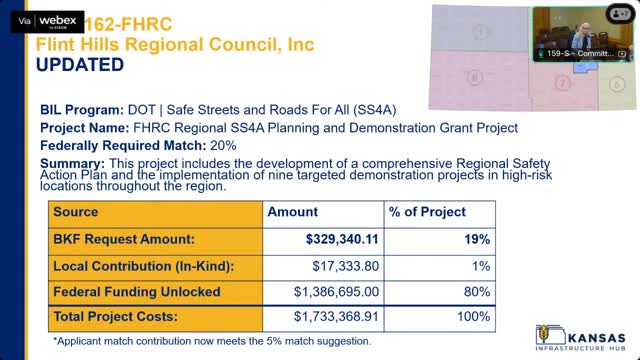Flint Hills Regional Council Approves Bridge Planning Funds for Franklin County
September 24, 2025 | Senate, Committees, Legislative, Kansas
This article was created by AI summarizing key points discussed. AI makes mistakes, so for full details and context, please refer to the video of the full meeting. Please report any errors so we can fix them. Report an error »

In a recent meeting of the Build Kansas Advisory Committee, members gathered to discuss critical infrastructure projects aimed at enhancing safety and accessibility across various communities. The atmosphere was charged with a sense of urgency as local representatives presented proposals that could significantly impact their regions.
One of the key discussions centered around the Flint Hills Regional Council, which received approval for a local contribution of $17,333. This funding is part of a broader initiative to implement nine targeted demonstration projects in high-risk areas, including railroad safety improvements and ADA accessibility enhancements in Onega. Senator Shellenberger raised pertinent questions about the nature of these demonstration projects, seeking clarity on whether they would involve constructing roads, sidewalks, or playgrounds. The committee confirmed that the projects would address specific safety concerns, such as traffic flow at schools and high-risk intersections.
The committee also reviewed a new application from the city of Baser, which aims to adopt strategies for creating safer streets. This initiative emphasizes not only urban neighborhoods but also the US 24 and US 40 Highway Corridor, with a request for $28,500 in funding. The committee swiftly approved this application, reflecting a consensus on the importance of promoting safety for all residents.
Another significant topic was the condition of two bridges in Franklin County, both rated as poor and critical for local commerce and emergency services. One bridge, a historic stone masonry arch built in 1930, is on the National Historic Registry, raising questions about preservation versus reconstruction. The committee discussed the necessity of a planning phase to assess the feasibility and community impact of potential repairs or replacements. This planning is crucial as it will inform a future application for a bridge investment program construction grant, which could ultimately address a total of 21 bridges in need of attention.
As the meeting progressed, members expressed concerns about the funding process and the role of the Kansas Department of Transportation (KDOT) in supporting these projects. Some representatives questioned whether KDOT could provide funding directly, given its substantial budget for highway and bridge maintenance. The committee agreed to follow up on these inquiries, ensuring that all options are explored before final approvals are made.
The discussions highlighted a collaborative effort among local leaders to address pressing infrastructure needs while balancing safety, historical preservation, and community impact. As the committee moves forward, the outcomes of these projects will not only shape the physical landscape of Kansas but also enhance the quality of life for its residents.
One of the key discussions centered around the Flint Hills Regional Council, which received approval for a local contribution of $17,333. This funding is part of a broader initiative to implement nine targeted demonstration projects in high-risk areas, including railroad safety improvements and ADA accessibility enhancements in Onega. Senator Shellenberger raised pertinent questions about the nature of these demonstration projects, seeking clarity on whether they would involve constructing roads, sidewalks, or playgrounds. The committee confirmed that the projects would address specific safety concerns, such as traffic flow at schools and high-risk intersections.
The committee also reviewed a new application from the city of Baser, which aims to adopt strategies for creating safer streets. This initiative emphasizes not only urban neighborhoods but also the US 24 and US 40 Highway Corridor, with a request for $28,500 in funding. The committee swiftly approved this application, reflecting a consensus on the importance of promoting safety for all residents.
Another significant topic was the condition of two bridges in Franklin County, both rated as poor and critical for local commerce and emergency services. One bridge, a historic stone masonry arch built in 1930, is on the National Historic Registry, raising questions about preservation versus reconstruction. The committee discussed the necessity of a planning phase to assess the feasibility and community impact of potential repairs or replacements. This planning is crucial as it will inform a future application for a bridge investment program construction grant, which could ultimately address a total of 21 bridges in need of attention.
As the meeting progressed, members expressed concerns about the funding process and the role of the Kansas Department of Transportation (KDOT) in supporting these projects. Some representatives questioned whether KDOT could provide funding directly, given its substantial budget for highway and bridge maintenance. The committee agreed to follow up on these inquiries, ensuring that all options are explored before final approvals are made.
The discussions highlighted a collaborative effort among local leaders to address pressing infrastructure needs while balancing safety, historical preservation, and community impact. As the committee moves forward, the outcomes of these projects will not only shape the physical landscape of Kansas but also enhance the quality of life for its residents.
View full meeting
This article is based on a recent meeting—watch the full video and explore the complete transcript for deeper insights into the discussion.
View full meeting
